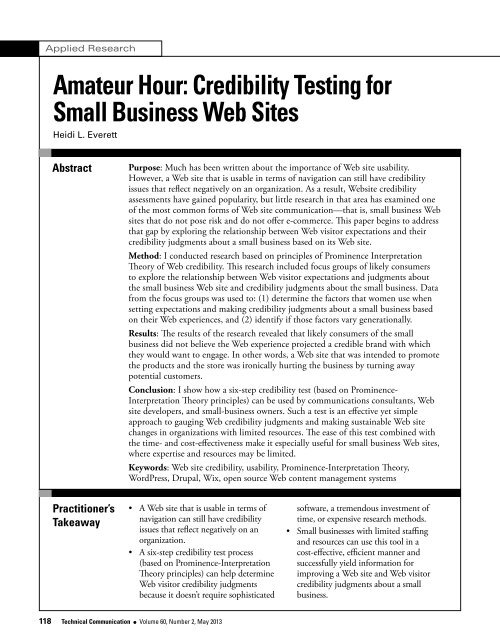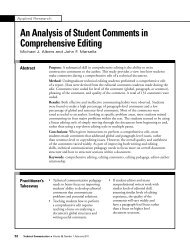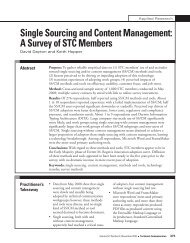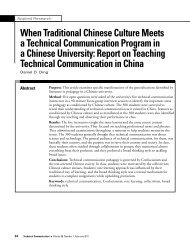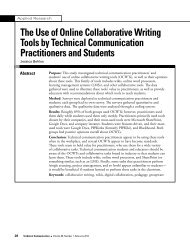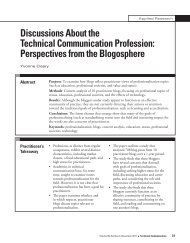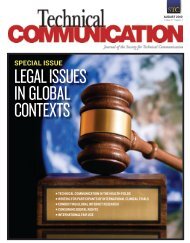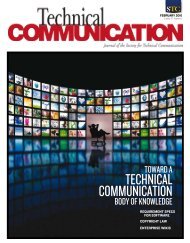Amateur Hour Credibility Testing for Small Business Web Sites
Credibility Testing for Small Business Web Sites - Technical ...
Credibility Testing for Small Business Web Sites - Technical ...
- No tags were found...
You also want an ePaper? Increase the reach of your titles
YUMPU automatically turns print PDFs into web optimized ePapers that Google loves.
Applied Research<strong>Amateur</strong> <strong>Hour</strong>: <strong>Credibility</strong> <strong>Testing</strong> <strong>for</strong><strong>Small</strong> <strong>Business</strong> <strong>Web</strong> <strong>Sites</strong>Heidi L. EverettAbstractPurpose: Much has been written about the importance of <strong>Web</strong> site usability.However, a <strong>Web</strong> site that is usable in terms of navigation can still have credibilityissues that reflect negatively on an organization. As a result, <strong>Web</strong>site credibilityassessments have gained popularity, but little research in that area has examined oneof the most common <strong>for</strong>ms of <strong>Web</strong> site communication—that is, small business <strong>Web</strong>sites that do not pose risk and do not offer e-commerce. This paper begins to addressthat gap by exploring the relationship between <strong>Web</strong> visitor expectations and theircredibility judgments about a small business based on its <strong>Web</strong> site.Method: I conducted research based on principles of Prominence InterpretationTheory of <strong>Web</strong> credibility. This research included focus groups of likely consumersto explore the relationship between <strong>Web</strong> visitor expectations and judgments aboutthe small business <strong>Web</strong> site and credibility judgments about the small business. Datafrom the focus groups was used to: (1) determine the factors that women use whensetting expectations and making credibility judgments about a small business basedon their <strong>Web</strong> experiences, and (2) identify if those factors vary generationally.Results: The results of the research revealed that likely consumers of the smallbusiness did not believe the <strong>Web</strong> experience projected a credible brand with whichthey would want to engage. In other words, a <strong>Web</strong> site that was intended to promotethe products and the store was ironically hurting the business by turning awaypotential customers.Conclusion: I show how a six-step credibility test (based on Prominence-Interpretation Theory principles) can be used by communications consultants, <strong>Web</strong>site developers, and small-business owners. Such a test is an effective yet simpleapproach to gauging <strong>Web</strong> credibility judgments and making sustainable <strong>Web</strong> sitechanges in organizations with limited resources. The ease of this test combined withthe time- and cost-effectiveness make it especially useful <strong>for</strong> small business <strong>Web</strong> sites,where expertise and resources may be limited.Keywords: <strong>Web</strong> site credibility, usability, Prominence-Interpretation Theory,WordPress, Drupal, Wix, open source <strong>Web</strong> content management systemsPractitioner’sTakeaway• A <strong>Web</strong> site that is usable in terms ofnavigation can still have credibilityissues that reflect negatively on anorganization.• A six-step credibility test process(based on Prominence-InterpretationTheory principles) can help determine<strong>Web</strong> visitor credibility judgmentsbecause it doesn’t require sophisticatedsoftware, a tremendous investment oftime, or expensive research methods.• <strong>Small</strong> businesses with limited staffingand resources can use this tool in acost-effective, efficient manner andsuccessfully yield in<strong>for</strong>mation <strong>for</strong>improving a <strong>Web</strong> site and <strong>Web</strong> visitorcredibility judgments about a smallbusiness.118 Technical Communication l Volume 60, Number 2, May 2013
Applied ResearchHeidi L. EverettIntroductionCost-effective, efficient <strong>Web</strong> site management isessential to most organizations. Much has been writtenabout the importance of <strong>Web</strong> site usability. However,a <strong>Web</strong> site that is usable in terms of navigation canstill have credibility issues that reflect negatively on anorganization.As a result, <strong>Web</strong> site credibility has gained popularityover the last decade, but research in this area has beenlimited to identifying credible authorities of in<strong>for</strong>mationand <strong>Web</strong> sites containing inherent risk. <strong>Web</strong> sites withinherent risk include those that provide medical, legal,or financial in<strong>for</strong>mation; those that ask <strong>for</strong> personalin<strong>for</strong>mation (like www.irs.gov); and those that allowfinancial transactions (e.g., banking, travel, ande-commerce sites). Little research has examined one ofthe most common <strong>for</strong>ms of <strong>Web</strong> site communication—that is, small business <strong>Web</strong> sites that do not pose riskand do not offer e-commerce. After all, as of 2010,the United States was home to 27.9 million smallbusinesses. A large number of those small businessesmay not deal in sensitive data or risk-related subjects,but visitors to their <strong>Web</strong> sites will still make judgmentsabout credibility when determining if they are willingto donate time or money to a nonprofit organization orto engage with a small business at its bricks and mortarlocation. The opposite can also be true. Much like poorusability, negative credibility judgments may negativelyimpact a customer’s engagement with a business—andultimately the businesses’ bottom line—especially whenyou factor in the recent trends in the development ofsmall business <strong>Web</strong> sites.Trends Influencing <strong>Small</strong> <strong>Business</strong><strong>Web</strong> <strong>Sites</strong>The credibility of small business <strong>Web</strong> sites becomes evenmore of an issue when you consider two developingtrends in <strong>Web</strong> communication. First, many smallorganizations—such as small businesses or nonprofits—do not have large staffs with dedicated <strong>Web</strong> site experts.For example, as of 2010, the United States was home to27.9 million small businesses; of those, 78.5% did nothave employees (<strong>Small</strong> <strong>Business</strong> Administration, 2012).As a result, small organizations often rely on volunteersor multi-tasking owners and their family members andfriends to make up <strong>for</strong> not having an IT departmentor <strong>Web</strong> communications team. In those situations, theorganization’s presence on the <strong>Web</strong> (and their overallcredibility) can be stunted by the creation of patchworksystems built to fulfill one person’s perspective (ratherthan an organizational strategy), built on the expertiseof one individual who is only with the organization<strong>for</strong> a limited time, or built by someone with initiativebut little knowledge of effective web communications(Merkel, et. al., 2007; Turnbow, et. al., 2005).The second trend is the availability of free or lowcostopen access <strong>Web</strong> site programs. Resources such asDrupal, blu domain, Wix and WordPress are attractiveto small businesses and non-profits because they providesoftware that’s easy to use <strong>for</strong> people inexperienced inhtml or coding, numerous template options with usablenavigation and design, and the ability to go live with a<strong>Web</strong> site in a matter of hours if an organization choosesto do so. In fact, of the top 10,000 small business <strong>Web</strong>sites in 2012, 60% were created in WordPress, 20% inDrupal (Wanner, 2012). That means, approximately8,000 small business <strong>Web</strong> sites were developed usingeither WordPress or Drupal. Despite their ease of use,such programs can have negative implications on anorganization’s <strong>Web</strong> presence, since speed and easeof development can overshadow the importance ofdetermining the effectiveness of the end product.In this paper, I explore the relationship between<strong>Web</strong> visitor expectations and their credibility judgmentsabout a small business based on the business’s <strong>Web</strong> site.Further, I show how a six-step credibility test (basedon Prominence-Interpretation Theory principles) is auseful tool <strong>for</strong> gauging <strong>Web</strong> credibility with web visitors,particularly in small businesses that have limited staffand financial resources. I begin by describing how<strong>Web</strong> site credibility research is different than <strong>Web</strong> siteusability, but just as important.Usability Versus <strong>Credibility</strong>Be<strong>for</strong>e discussing how to conduct <strong>Web</strong> site credibilityresearch, it’s important to understand how it differsfrom usability research. According to The InternationalStandards Organization (1998, 9241-11), usability is the“extent to which a product can be used by specified usersVolume 60, Number 2, May 2013 l Technical Communication 119
Applied Research<strong>Credibility</strong> <strong>Testing</strong> <strong>for</strong> <strong>Small</strong> <strong>Business</strong> <strong>Web</strong> <strong>Sites</strong>to achieve specified goals with effectiveness, efficiency,and satisfaction in a specified context of use.” A centraltenet of usability testing, then, is having likely userscomplete task-based scenarios to gather data abouteffectiveness, efficiency, and user satisfaction (Barnum,2011, p. 18). This perspective has made usabilityimportant and widely researched in the field of technicalcommunication. In fact, a Google Scholar search of thephrase <strong>Web</strong> site usability yields more than 70,400 resultsalone.Although usability research can lead to importantdiscoveries, technical communication researchers andpractitioners can benefit from understanding andemploying additional methods of <strong>Web</strong> site evaluation.One area of research that can be beneficial is <strong>Web</strong> sitecredibility. As David Robins and Jason Holmes (2008)explained:[F]irst impressions are crucial <strong>for</strong> web pagecontent. Regardless of the quality or credibilityof content, a poorly designed or aestheticallyunappealing web page will likely producea negative impression of credibility. In anenvironment such as the World Wide <strong>Web</strong>, wherethere are billions of documents and thousandsof pages on a given topic, it is critical to presentin<strong>for</strong>mation in such a way that it does notproduce a negative visceral judgment be<strong>for</strong>e theviewer even has a chance to engage the content atthe cognitive level. People are quick to abandona site and move on to one of any number ofcompeting options. Lack of perceived credibility issurely one of the reasons <strong>for</strong> this behavior. (p. 398)<strong>Web</strong> site credibility can be defined in a numberof specific ways. For example, it can be viewed as:(1) the credibility of the in<strong>for</strong>mation available onthe web and (2) the credibility of an organizationpresenting the in<strong>for</strong>mation. <strong>Credibility</strong> assessmentsmay be impacted by factors such as design features ofa <strong>Web</strong> site, certifications of the in<strong>for</strong>mation presented,or certifications of the organization presenting thein<strong>for</strong>mation (Fogg, Soohoo, et. al., 2003; Lazar,Meiselwitz & Feng, 2007). Search engine rankings mayalso impact credibility assessment (Kammerer & Gerjets,2012). Moreover, factors like product in<strong>for</strong>mation, theonline shopping experience, and customer support mayimpact credibility (Fogg, Soohoo, et. al., 2003; Elliot& Surgi Speck, 2005). Perceived amateurism is anotherfactor considered when making credibility judgments(Fogg, et. al., 2001, p. 63). <strong>Amateur</strong>ism has beenconnected to the size of the <strong>Web</strong> site, the site domainname, typographical errors, whether the site was hostedby a third party and whether or not the site had beenupdated. Finally, Miriam Metzger (2008) synthesizedan extensive list of factors from existing research thatincluded such details as date stamping, presence ofcontact in<strong>for</strong>mation and privacy and security policies,broken links, a user’s prior experience on the <strong>Web</strong>,and URL (p. 2082). Metzger’s own research notes thatuser credibility assessments also depend on the user’smotivation and ability to assess.Although some of these many factors relate todesign elements—and design is often the first element<strong>Web</strong> users interpret—it’s important to note thatsimply having a visually appealing <strong>Web</strong> site does notautomatically equate to credibility. A <strong>Web</strong> site can bevisually appealing; that is to say its aesthetics as theyrelate to color choice, font usage, harmony of design,and use of white space can be pleasing to <strong>Web</strong> sitevisitors. Visually appealing <strong>Web</strong> sites can still fosternegative credibility judgments about a <strong>Web</strong> site.The bottom line is that credibility differs fromusability in that it moves beyond the efficiency andsatisfaction of a <strong>Web</strong> site to explore perceptionsof credibility by web visitors. In short, it shifts thequestion from “Is a <strong>Web</strong> site usable?” to “Is a <strong>Web</strong> sitecredible?” In addition, research on <strong>Web</strong> site credibilityextends beyond the <strong>Web</strong> site to ask the question “Is theorganization that is responsible <strong>for</strong> this <strong>Web</strong> site credible?”Usability testing alone only answers the first question,which may leave fatal flaws in the <strong>Web</strong> site execution.Assessing <strong>Credibility</strong>One of the best ways to assess credibility is throughProminence-Interpretation Theory (Fogg, 2002).This theory considers two important factors: (1) a<strong>Web</strong> site element’s likelihood of being noticed—that is, its prominence—as well as (2) what value ormeaning people assign to that element—that is, theirinterpretation of it. The prominence and interpretationof an element may be influenced by many factors,120 Technical Communication l Volume 60, Number 2, May 2013
Applied ResearchHeidi L. Everettincluding a <strong>Web</strong> visitor’s motivation <strong>for</strong> visiting a <strong>Web</strong>site and the visitor’s prior experience with the <strong>Web</strong>(Fogg, 2002).Both Fogg and Metzger have called <strong>for</strong> research tofurther understand how user motivation specificallyimpacts credibility judgments. For example, if a <strong>Web</strong>visitor is looking <strong>for</strong> answers to a medical question (<strong>for</strong>“a loved one who is in dire need”), the <strong>Web</strong> visitor willhave a high level of motivation and spend a considerablemore amount of time with a <strong>Web</strong> site be<strong>for</strong>e makinga judgment that it is time to move on to another site(Fogg, p. 12, 2003). In contrast, a person searching <strong>for</strong>a local gift shop or <strong>for</strong> a local nonprofit organizationto donate money to typically will not have a high levelof motivation to engage with a <strong>Web</strong> site. In that sense,credibility may become increasingly important <strong>for</strong> smallbusinesses if they do not require a high level of <strong>Web</strong>visitor motivation to visit their <strong>Web</strong> sites. The bottomline is that first impressions by <strong>Web</strong> visitors may bequick and detrimental to an organization if prominentelements do not yield an interpretation of credibility.The good news is that credibility research can beconducted by organizations with little time or money.Prominence-Interpretation Theory is ideal <strong>for</strong> smallbusinesses in particular because it doesn’t requiresophisticated software, a tremendous investment of time,or expensive research methods. <strong>Small</strong> businesses withlimited staffing and resources can implement this tool ina cost-effective, efficient manner and successfully yielduseful in<strong>for</strong>mation <strong>for</strong> improving a <strong>Web</strong> site and <strong>Web</strong>visitor credibility judgments. In fact, Fogg, Soohoo,Danielson, and colleagues (2003), acknowledged thatalthough their sample size of 2,684 participants wasquite large, their pilot study results (which consistedof 200 participants) yielded valuable insights into thecredibility of <strong>Web</strong> sites (p. 14); the most valuable datafrom their research came from the qualitative commentsthat people made about the <strong>Web</strong> sites they evaluated asopposed to the quantitative rankings (p. 3).Six Steps to Assessing <strong>Credibility</strong>Store managers, business owners, volunteers or stafftasked with building and maintaining a <strong>Web</strong> site mighthave clear intentions <strong>for</strong> their selection of images andtext; however, credibility testing can help identify iftheir <strong>Web</strong> sites yield a credible brand experience <strong>for</strong>consumers or a negative credibility judgment that harmsthe business.To that end, I have developed a simple six-stepprocess <strong>for</strong> conducting cost-effective credibility testing,which is guided by the principles of Prominence-Interpretation Theory:Step 1. Identify and recruit focus groupparticipants. Much like usability studies, it is importantto recruit current or likely consumers of a business.Interviews may be used in place of focus groups;however, focus groups provide the opportunity toconnect with many users in a timely manner (MacNealy,1999; Morgan, 1988; Stewart & Shamdasani, 1990).Step 2. Determine online experiences andexpectations of participants, particularly as they mightrelate to a specific business or organization withquestions like:• What is your experience with the <strong>Web</strong>?• What activities do you participate in on the <strong>Web</strong>and how often?• What would motivate you to visit our <strong>Web</strong> site?• What are your expectations when you visit our <strong>Web</strong>site or a <strong>Web</strong> site <strong>for</strong> a business similar to ours?•Step 3. Walk focus group participants throughthe <strong>Web</strong> site and note their responses to the followingquestions:• When you view this page, which elements areprominent to you?• What is your interpretation of this element andwhy?• How important is this particular element to your<strong>Web</strong> site visit and why?It is important to remember that this point of theresearch is not the same as usability testing. The goalis not to see whether the participants can successfullynavigate, but to identify what they notice on the <strong>Web</strong>site and how they interpret the different elements.Step 4. Document responses. Focus groupresponses can be documented with the assistance ofnote takers and can be audio or video recorded andfully transcribed. To help ensure the credibility ofthe findings, member checking (Erlandson, Harris,Volume 60, Number 2, May 2013 l Technical Communication 121
Applied Research<strong>Credibility</strong> <strong>Testing</strong> <strong>for</strong> <strong>Small</strong> <strong>Business</strong> <strong>Web</strong> <strong>Sites</strong>Skipper, & Allen, 1993; Lincoln & Guba, 1985) can beemployed to summarize, restate, and verify participantexpectations, interpretations, credibility judgments, andexperiences with the <strong>Web</strong> or organization.Step 5. Analyze participant comments toidentify elements of the <strong>Web</strong> site that both positivelyand negatively influence the credibility judgments thatvisitors make. Statements should be analyzed using opencoding to <strong>for</strong>m categories based on similarities of thelanguage used. Statements can be compared, contrasted,and combined in main categories or subcategories andsometimes renamed until they are reduced to a pointwhere further reduction of the list is no longer possible(Glaser & Horton, 2004).Step 6. Determine key improvements that canbe made to the <strong>Web</strong> site. The improvements must focuson the most troublesome areas, must address credibilityconcerns identified by visitors, and must factor in thetime and resources of the organization that will need toimplement the improvements.The following case illustrates the simplicity, power,and effectiveness of this process.<strong>Credibility</strong> <strong>Testing</strong> in ActionIn the following paragraphs, I demonstrate how the sixstepcredibility testing process was put to use <strong>for</strong> smallbusiness <strong>Web</strong> sites and led to significant improvements.The small business <strong>Web</strong> site examined in this sectionwas chosen because it shares commonalities with manysmall business <strong>Web</strong> sites—including the two influencesdescribed above: it was created with a low-cost opensource program and is maintained by a few parttimeemployees with no prior experience in <strong>Web</strong> sitemaintenance or marketing.Overview of <strong>Web</strong> SiteOn A Lark (OAL) is a gift boutique that employs onefull-time manager, two part-time sales associates, andstudent workers throughout the academic year whoqualify <strong>for</strong> work-study awards. When the shop openedin fall 2009, the manager invested in a $50 open-access,flash-based <strong>Web</strong> site template from blu domain. Thestaff took pictures in the storage room with a personalcamera and went live with a <strong>Web</strong> site in one day.The store’s <strong>Web</strong> site, www.giftsonalark.com, is not ane-commerce site <strong>for</strong> two reasons. First, as a boutique, theproduct line is ever changing and products are purchasedin small quantity. Second, since OAL only has a smallstaff, the manager was concerned about the maintenanceand sustainability of the site, in particular productavailability and accuracy. Their intent was to have a <strong>Web</strong>presence that showcased the store’s ambiance, location,and unique gifts and that drove consumer traffic to thestore and Facebook site.Step 1: Identify and Recruit ParticipantsPeople who were considered likely consumers of OALwere recruited <strong>for</strong> four focus group sessions. Two focusgroups consisted of 18- to 22-year-old female collegestudents. The other two focus groups consisted ofprofessional women ages 30 to 49. Of the four focusgroups, the participants <strong>for</strong> three of the focus groupswere recruited from the population of College of SaintBenedict, which is the college that owns and operatesOAL and which is located across the street from thestore. The fourth focus group included professionalwomen recruited from within one hour of the store.Of the 34 focus group participants, 17 had beento the retail site OAL; all 17 enjoyed the breadth anduniqueness of product as well as ambiance of the store—and 13 of those participants had made purchases fromOAL in the past. The remaining 17 participants had notheard of OAL be<strong>for</strong>e the credibility test. None of theparticipants had visited the <strong>Web</strong> site www.giftsonalark.com.Step 2: Determine Online Experiences andExpectationsBased on Fogg’s factors that influence <strong>Web</strong> credibilityjudgments, questions were asked to determine <strong>Web</strong>visitor intent, expectations, motivation, and priorexperiences on the <strong>Web</strong>. The questions also addressedwhat <strong>Web</strong> visitors viewed as prominent elements of the<strong>Web</strong> site as well as their interpretation of these elements.Questions included:• “Tell me what activities you do on the web and howoften you do them?”• “What might motivate you to visit the <strong>Web</strong> sitewww.giftsonalark.com?”122 Technical Communication l Volume 60, Number 2, May 2013
Applied ResearchHeidi L. EverettData from this stage of the process was used to:(1) determine the factors that women use when settingexpectations and making credibility judgments about asmall business based on their <strong>Web</strong> experiences, and (2)identify if those factors vary generationally.Step 3: Walk Participants through the <strong>Web</strong> SiteDuring the focus group, participants were asked to lookat all <strong>Web</strong> pages of www.giftsonalark.com to provideinitial reactions and respond to discussion questions.Questions included:• “When you first look at this page of www.giftsonalark.com which elements grab yourattention and why?”• “How important is this particular element to your<strong>Web</strong> site visit and why?”Step 4: Document ResponsesDiscussions were transcribed. I served as moderator anda note taker <strong>for</strong> all focus groups. The two focus groups of18- to 22-year-olds included three additional note takersbecause these two groups had more than ten participantsin each group. One focus group included one additionalnote taker besides me, and I served as the moderatorand sole note taker <strong>for</strong> one focus group that had threeparticipants.Step 5: Analyze CommentsAll statements <strong>for</strong> each focus group were organizedinto a unit <strong>for</strong> generational segmentation. Then, allstatements were mixed with group identificationremoved. Statements were analyzed using opencoding to <strong>for</strong>m categories based on similarities of thelanguage used. Statements were compared, contrasted,and combined in main categories or subcategoriesand sometimes renamed until they were reduced to apoint where further reduction of the list was no longerpossible. The resulting list highlighted factors thatinfluence expectations and credibility judgments about<strong>Web</strong> experiences <strong>for</strong> visitors to www.giftsonalark.com.Final analysis revealed that focus group participants whowere motivated to browse the OAL <strong>Web</strong> site expectedthe retail <strong>Web</strong> site to:1) Clearly, quickly identify what the retailestablishment offersFigure 1. OAL Home PageWhile store employees intended to promote new brand elements onthe home page, these prominent elements prompted focus groupparticipant interpretations that questioned the store’s purpose. Somewondered if it was a pet store or a bookstore. Participants indicatedthe site looked “ignored” or “neglected,” questioning the accuracyand newness of the site or store, in general.2) Make it easy to engage with the business3) Be current, accurate, and purposefulThe credibility test revealed that those expectationswere not met <strong>for</strong> likely consumers of OAL. There<strong>for</strong>e,the participants did not believe the <strong>Web</strong> site projectedthe level of credibility that would inspire them to engagewith the company by visiting OAL’s store in the future.Specifically, five key findings were identified. Thosefindings are described in detail below.Finding 1. When the home page (Figure 1) wascreated, the intent was to raise awareness about variouselements of the new brand, including the store name,logo, and tagline. There<strong>for</strong>e, these were positioned asthe most prominent elements on the OAL home page.Other elements included five navigational links and anote that said the product is ever changing, so consumershould stop by the store often.Focus group participants did not interpret thehome page favorably. The prominent elements of thispage did not clarify the store’s product offering. Somefocus group participants made credibility judgmentsabout the store neglecting or ignoring its <strong>Web</strong> site. Forexample, two focus group participants who were notfamiliar with the store asked if it was a bookstore or aVolume 60, Number 2, May 2013 l Technical Communication 123
Applied Research<strong>Credibility</strong> <strong>Testing</strong> <strong>for</strong> <strong>Small</strong> <strong>Business</strong> <strong>Web</strong> <strong>Sites</strong>Figure 2. Extraordinary Things Second-Level PageFigure 3. About Lark PageFocus group participants, in general, were still unclear what On A Larkoffers consumers based on the prominent elements of the ExtraordinaryThings pages. In addition, several participants noted frustration thatthey would have to click two additional times to find products.pet store after viewing the home page. Among the 18- to22-year olds, nearly all said they would not be inclinedto search deeper into the site based on this page. Onewoman noted, “Yeah. If you make me work <strong>for</strong> it, I’llleave.” Participants in the 30- to 49-year old group saidthey might be willing to look at one additional pagetitled Extraordinary Things, which they assumed to be aproduct page.Finding 2. While focus group participants wereinitially pleased to finally see prominently displayedproducts on the Extraordinary Things page (Figure 2),the absence of product descriptions, general productcategories, and pricing limited the <strong>Web</strong> site visitors’ability to grasp what OAL offers.Moreover, the prominence of the white space—and limited product—was again interpreted as the sitebeing neglected. Responses included: “Why does theExtraordinary Things page take me to another pagecalled Extraordinary Things?” and “Are we waiting <strong>for</strong>more to load?”Participants who had expressed a willingness toclick on the Extraordinary Things page after beingdisappointed with the home page noted they would endtheir <strong>Web</strong> visit.Finding 3. Across all focus groups, the About Larkpage (Figure 3) caused an instant, audible, and positivereaction. Focus group participants who were familiarwith OAL felt the prominent interior store photo on thispage represented the experience of OAL.Focus group participant interpretations about On A Lark shifteddramatically based on the prominent elements of this page. Theyfelt positive about the store ambiance and product line. The text thatidentified College of Saint Benedict as the owner and operator of thestore generated discussion about the use of profits to support studentscholarships, which also lent credibility to OAL <strong>for</strong> the likely consumers.Those not familiar with the store were immediatelyintrigued by it and made comments such as:• “It looks cute.”• “It looks fun.”• “This picture makes me want to go there.”• “It looks cool.”• “Eclectic. I like it.”• “Like searching <strong>for</strong> a good hotel, you want to seewhere you are going.”• “I want to get to know the place.”• “It’s cuter to see the store than the items.”The About Lark page was also the first pagethat offered body copy instead of just headings andsubheadings:A visit to On A Lark will engage all your senseswhether you are a first time customer or loyal Larkfan. Our extraordinary things are ever changing,so stop in often. On A Lark is proudly owned andoperated by College of Saint Benedict.Most focus group members liked the first twolines of the body copy to set expectations about whatOAL has to offer consumers, namely an ever-changingproduct line that one has to experience in store.124 Technical Communication l Volume 60, Number 2, May 2013
Applied ResearchHeidi L. EverettFigure 4. Store <strong>Hour</strong>s/Location PageFigure 5. Contact Us PageParticipants felt this page lent credibility to OAL because the storeis a destination shopping experience. Consumers have to plan to gothere. As a result, participants noted the hours of operations and visualidentification of the store exterior would help consumers plan theirexcursion. The one negative interpretation was the use of a seasonalstore exterior, which gave the impression of being dated and neglected.Overall, the prominent image and introduction ofbody copy yielded positive interpretations about the smallbusiness and its credibility as a retailer.The third line, “owned and operated by College ofSaint Benedict,” generated conversation about why Collegeof Saint Benedict owns the store and how profits are used,namely to support student scholarships. Of the 34 focusgroup participants, all believed further explanation about theOAL and CSB relationship was essential. More importantly,they felt the relationship—as well as the financial supportof student scholarships—should be celebrated; this, in turn,would lead to repeat business as well as positive feelingsabout purchases because the profit was put to good use.Participants offered the following comments:• “Knowing that profits support student scholarshipsmakes me feel better about my purchase. This alignswith my giving priorities.”• “That makes me want to shop more. I’d bring mysisters.”• “I’m so taking my mom there when she picks me up<strong>for</strong> break.”All focus group participants recommended theprominent elements of this page be placed on the homepage where they would be well received and would setexpectations about the shopping experience in store andon the <strong>Web</strong> site.Participants believed this page to be a disservice to consumers by notoffering complete contact in<strong>for</strong>mation, including a store address toprogram in a global positioning system. Further, participants interpretedthe photograph as a waste of space that did not motivate consumers towant to go to the store.Finding 4. Overall, focus group participants believedthe Store page lent credibility to OAL by providinghelpful in<strong>for</strong>mation to the consumer (Figure 4).First, the in<strong>for</strong>mation on this page was useful andprominent, particularly <strong>for</strong> consumers who have tomake OAL a destination site rather than an impulseshopping experience. Because the store is located in asmall college town, consumers who do not live or workin St. Joseph, MN must make a conscious, intentionalef<strong>for</strong>t to go there. Knowing the days and hours that thestore is in operation would allow consumers to plantheir shopping trips to OAL, participants noted. Manyparticipants commented that showing the exterior imageof the storefront helped consumers not familiar withSaint Joseph, MN easily recognize and locate the storewhen visiting the town.The one negative interpretation expressed by a fewfocus group members was the use of a seasonal exteriorstorefront that made the site appear dated and neglected.Focus groups took place in spring; however, the photowas believed to be from autumn, since it featuredpumpkins.Finding 5. More than half of all focus groupparticipants commented negatively about the ContactUs page (Figure 5). They noted the store manager’scontact in<strong>for</strong>mation was easily located on the pagesAbout Lark and Store <strong>Hour</strong>s/Location but incompleteand not at all prominent on the actual Contact Uspage. Nearly all focus participants believe the contactin<strong>for</strong>mation should only be on the Contact Us page.Volume 60, Number 2, May 2013 l Technical Communication 125
Applied Research<strong>Credibility</strong> <strong>Testing</strong> <strong>for</strong> <strong>Small</strong> <strong>Business</strong> <strong>Web</strong> <strong>Sites</strong>Figure 6a and 6b OAL Home Page and About Lark PageParticipants were asked to rate their interest in OAL based onviewing these two pages of the OAL <strong>Web</strong> site. The figure at leftgenerated little to no interest; the figure at right generated a flurry ofexcitement and interest.Not one focus group participant liked the prominentphoto on this page. In one woman’s words, “That doesnothing.” All recommended another store interior shotthat would showcase the ambiance of the store.Focus group participants were asked to rate theirinterest in OAL based on their exposure to the OALhome page (Figure 6a). Their rating was based on a scaleof 1 to 10 with 1 being “I have no interest in OAL” to10 being “I must visit OAL.” They were also asked torate their interest in OAL based on their exposure to theAbout Lark page (Figures 6a and 6b) using the same scale.Of the 34 participants, 27 expressed little or nointerest in the OAL retail site based on the home page(figure 6a). Their responses are reflected in the left-handcolumns of the graph (figure 7). Nearly all of the 18- to22-year-old participants said they would not click toanother page to learn more, nor would they visit thestore. Simply put, the home page (with its prominentgraphic and white space) did not translate to a credibleorganization with which they would want to engage. Afew of the older participants noted they’d be willing tolook at one more page be<strong>for</strong>e abandoning the site andthe organization. After viewing the About Lark page(Figure 6b), however, all 34 participants expressed morethan moderate interest in OAL as indicated by the righthandcolumns in the graph below (Figure 7).The key difference that led to such opposingcredibility judgments was the one prominent graphic.The single, prominent logo on the home page (which wasused to establish the brand identity) was not interpretedfavorably because it did not provide consumers clarityabout OAL and what it offered. The single, prominentstore interior shot, on the other hand, captured attentionand inspired <strong>Web</strong> visitors to want to learn more.Step 6: Determine ImprovementsBased on results of the study, a number of improvementswere identified that could be made to OAL’s <strong>Web</strong>site to improve the site’s prominent elements, yieldpositive interpretation of those elements, and, as aresult, improve the organization’s overall credibility.In determining the improvements, the limited staffand resources of OAL were considered—since thosefactors would influence whether the organization couldimplement and sustain the improvements.The screen captures that follow illustratethe improvements that were identified <strong>for</strong> (andsubsequently made to) www.gifstonalark.com based onthe credibility test.Improvement 1. Set ambiance and expectations.The home page of the site was revised to showcaseinterior images of the store as well as a few products(Figure 8).Figure 8. Intriguing New Home PageFigure 7Participants’ Interest in OAL Based on the OAL Home Page (Left,Blue) and the About Lark Page (Right, Red)The prominent elements of the new home page showcase product andambiance as well as the store’s support of student scholarships andever-changing product line.126 Technical Communication l Volume 60, Number 2, May 2013
Applied ResearchHeidi L. EverettFigure 9. Showcasing Product CategoriesFigure 10. Updated Store <strong>Hour</strong>s and Location PageThe prominence of clearly defined product categories and bold imagesidentify what the store offers and help consumers make the decision toplan an in-store shopping trip to OAL.The prominence of the storefront from the view of the main intersectionallows consumers to quickly identify the location of the store.The revised home page was updated to make thoseelements more prominent. In doing so, the home pageestablishes the ambiance of the retail site, rein<strong>for</strong>ces the‘boutique’ brand experience, and suggests the productline is unique and fun. The addition of body copy makesit clear that the store is owned by the college and thatprofits are used <strong>for</strong> scholarships. In addition, the copyencourages visitors to visit the store frequently:On A Lark is owned and operated by Collegeof Saint Benedict. 100% of our profits supportextraordinary Saint Ben’s women throughscholarships. Our extraordinary items are everchanging,so stop in often.Improvement 2. Clearly identify productcategories. The majority of focus group participantsagreed that several clearly defined product categories—coupled with images of the store’s ambiance—woulddrive traffic to the store from the Extraordinary Thingspage (Figure 9). Comments explaining the expectationsand interpretations surrounding this change include:• “I need to know it’s worth my time to go there.”• “I don’t expect small specialty stores to sell theirproduct online. But, I like to check their <strong>Web</strong> siteto make sure they are still around and get theirhours.”• “If I’m going on vacation, I search the web to seewhat kinds of boutiques and antique stores are inthe town, so I can visit them. Based on their <strong>Web</strong>site, I decide if I’m going to go to the store.”Nearly all focus group participants agreed thatproduct categories should be clearly labeled rather than,in their words, clever or cutesy; clear labeling helps theconsumer quickly identify types of products available.Focus group participants, in general, believed itwasn’t necessary to include third-level pages <strong>for</strong> eachproduct category since consumers couldn’t makepurchases on the site and product was always changing.Improvement 3. Help locate store. The primarychange to the Store <strong>Hour</strong>s and Location page (Figure10) was adding a prominent non-seasonal photograph ofthe storefront taken from the main intersection in townto give visitors a visible reference <strong>for</strong> locating the store.The use of a non-seasonal photograph helps ensure thesite doesn’t look dated and unkempt.Improvement 4. Use <strong>Web</strong>page real estate wisely.This improvement included replacing the image on theContact Us page with an interior store shot that madethe store’s ambiance more prominent (Figure 11); Usinganother interior store shot rein<strong>for</strong>ces the ambiance ofthe in-store experience. The image also provides a visualoverview of additional products in the store.Overview of Improvements. The changes made tothe prominent elements of OAL’s <strong>Web</strong> site elevate thebrand experience <strong>for</strong> web visitors to align with the retailstore experience. The limited body copy is prominenton every page and establishes clear expectations aboutthe <strong>Web</strong> site’s purpose, and the addition of moreVolume 60, Number 2, May 2013 l Technical Communication 127
Applied Research<strong>Credibility</strong> <strong>Testing</strong> <strong>for</strong> <strong>Small</strong> <strong>Business</strong> <strong>Web</strong> <strong>Sites</strong>Figure 11. Updated Contact Us PageThe prominence of the store interior rein<strong>for</strong>ces the ambiance of thein-store experience and, again, showcases product.interior photos and representative product photosadd to consumer enjoyment and interest in the OALexperience, hopefully driving traffic to the store bymaking it easy to engage. In addition, the changes wereintended to have a long shelf life, so the small staff atOAL only had to focus on updating store hours whenthey change.Uses and Implications of Prominence-Interpretation TheoryWhen a <strong>Web</strong> visitor goes to a <strong>Web</strong> site, they notice<strong>Web</strong> site elements; that is to say that <strong>Web</strong> site elementswill be prominent to them. Subsequently, they willmake interpretations about these elements, leading to acredibility judgment about the <strong>Web</strong> site, the in<strong>for</strong>mationpresented, and the organization sponsoring the site.Much of the <strong>Web</strong> site credibility research conducted todate analyzes <strong>Web</strong> visitor feedback on <strong>Web</strong> sites thatlikely would be visited with a high level of motivationand some inherent risk, such as <strong>Web</strong> sites focusingon health in<strong>for</strong>mation, requiring input of personalin<strong>for</strong>mation, or offering financial transactions.<strong>Credibility</strong> becomes increasingly important <strong>for</strong> smallbusinesses if they do not require a high level of <strong>Web</strong>visitor motivation to visit or inherent risk to engagewith their <strong>Web</strong> sites, After all, first impressions by <strong>Web</strong>visitors may be quick and detrimental to an organizationif prominent elements do not yield an interpretation ofcredibility and subsequent engagement with the businessor services. Conducting credibility testing (based onProminence-Interpretation Theory principles) providesa simple, cost-effective process <strong>for</strong> identifying credibilityissues and improving <strong>Web</strong> sites. Below, I suggest theimplications and uses of this testing <strong>for</strong> a variety oftechnical communication scholars, consultants, andpractitioners.For PractitionersUsability testing is a valuable tool to ensure a <strong>Web</strong> site isfunctional in its ease of use. A <strong>Web</strong> site that is usable interms of navigation can still have credibility issues thatreflect negatively on an organization. In fact, free or lowcast<strong>Web</strong> site software that may be deployed by smallbusinesses (like Drupal, blu domain or WordPress) oftenhave tested, usable navigation as well as aestheticallypleasing design skin. As the case study above suggests,these positive attributes of On A Lark’s blu domain<strong>Web</strong> development software were not sufficient to yieldpositive credibility judgments about the organizationOn A Lark.For Technical Communication ScholarsSimilarly <strong>for</strong> technical communications scholars, weneed additional research to branch out and broadenour understanding of <strong>Web</strong> visitor credibility judgmentsabout organizations that do not have an inherentrisk or high level of motivation essential to their <strong>Web</strong>visitor experience. Further research could exploreif expectations and credibility judgments are more<strong>for</strong>giving based on the size, location, or purpose of anorganization; that is to say, do <strong>Web</strong> visitor expectationschange based on the scope of the organization withwhich they are trying to engage? To put it another way,do <strong>Web</strong> visitor expectations differ when visiting a site <strong>for</strong>a bed and breakfast versus an international hotel chain?Do <strong>Web</strong> visitor expectations differ when visiting a site<strong>for</strong> a small boutique versus a regional or national retaileror big box store? Do <strong>Web</strong> visitor expectations differwhen visiting a site <strong>for</strong> a local plumber versus a regionalor national trade franchise?Another area worthy of investigation is the conceptof amateurism. In past <strong>Web</strong> credibility research,amateurism was one of the factors participantsconsidered when making credibility judgments (Fogg, et.al., 2001, p. 63). <strong>Amateur</strong>ism has been connected to thesize of the <strong>Web</strong> site, the site domain name, typographicalerrors, whether the site was hosted by a third party (like128 Technical Communication l Volume 60, Number 2, May 2013
Applied ResearchHeidi L. EverettWordPress or Drupal) and whether or not the site hadbeen updated, among other things. In the case of On ALark, the <strong>Web</strong> site offers only six pages and was designedto have a long shelf life with few updates due to resourceconstraints. In addition, the <strong>Web</strong> address includes thestore name; however, the use of only the store namewas not available because another store of the samename exists in another state. Based on these elements,credibility judgments would be expected to decreasebased on past research. As scholars, we must furtherexamine if negative <strong>Web</strong> visitor credibility judgments aremitigated by a sliding scale of expectations, particularly<strong>for</strong> small businesses.For TeachersAs educators, we must help our students understandthe importance of credibility judgments in conjunctionwith usability when analyzing effectiveness of <strong>Web</strong> sites.This teaching should provide a broader perspective ofcredibility beyond safety, security, data integrity, andaesthetics. Introducing Prominence-InterpretationTheory principles and credibility testing would serve asa valuable method <strong>for</strong> evaluating credibility judgmentsabout an organization based on its <strong>Web</strong> site.Technology has made it easier <strong>for</strong> organizationsto develop a <strong>Web</strong> presence, even if they do not havefull-time staff members who are trained in coding or<strong>Web</strong> communication strategies. The end result maybe <strong>Web</strong> sites that are usable and credible in terms ofdesign and navigation, but that lack credibility from acommunication standpoint. <strong>Credibility</strong> research canbe conducted by those organizations with little timeor money using Prominence-Interpretation Theoryprinciples. That research can uncover specific actionablelessons that dramatically increase the credibility of a <strong>Web</strong>site and the organization.ReferencesBarnum, C. M. (2011). Usability testing essentials: Ready,set, test! Burlington, MA: Elsevier.Conrad, J. G., Leidner, J. L., & Schilder, F. (2008).Professional credibility: authority on the <strong>Web</strong>. InProceedings of the 2nd ACM workshop on in<strong>for</strong>mationcredibility on the <strong>Web</strong> (pp. 85-88). New York, NY:ACM.Elliot, M., & Surgi Speck, P. (2005). Factors thataffect attitude toward a retail <strong>Web</strong> site. Journal ofMarketing Theory and Practice, 13, 40-51.Erlandson, D. A., Harris, E. L., Skipper, B. L., & Allen,S. D. (1993). Doing naturalistic inquiry: A guide tomethods. Newbury Park, CA: Sage.Fogg, B.J. (2002). Prominence-interpretation theory:Explaining how people assess credibility. A research reportfrom the Stan<strong>for</strong>d Persuasive Technology Lab. Stan<strong>for</strong>dUniversity. Retrieved from credibility.stan<strong>for</strong>d.edu/pit.html or www.webcredibility.org/pit.html.Fogg, B. J., Marshall, J., Laraki, O., Osipovich, A.,Varma, C., Fang, N., Jyoti, P., et al. (2001). Whatmakes <strong>Web</strong> sites credible? A report on a largequantitative study. In Proceedings of the SIGCHIConference on Human Factors in Computing Systems(pp. 61-69). New York, NY: ACM.Glaser, B., & Holton, J. (2004). Remodeling groundedtheory. Forum Qualitative Sozial<strong>for</strong>schung / Forum:Qualitative Social Research, 5(2). Retrieved fromhttp://www.qualitative research.net/index.php/fqs/article/view/607/1315International Standards Organization.(1998). Ergonomicrequirements <strong>for</strong> office work with visual displayterminals (VDTs); Part 11—Guidance on usability.ISO 9241-11: 2.Kammerer, Y., & Gerjets, P. (2012). How search engineusers evaluate and select <strong>Web</strong> search results: Theimpact of the search engine interface on credibilityassessments. Library and In<strong>for</strong>mation Science, 4,251-279.Volume 60, Number 2, May 2013 l Technical Communication 129
Applied Research<strong>Credibility</strong> <strong>Testing</strong> <strong>for</strong> <strong>Small</strong> <strong>Business</strong> <strong>Web</strong> <strong>Sites</strong>Lazar, J., Meiselwitz, G., & Feng, J. (2007).Understanding <strong>Web</strong> credibility: A synthesis ofthe research literature. Foundations and Trends inHuman-Computer Interaction, 1(2), 139-202.Lincoln, Y. S., & Guba, E. G. (1985). Naturalisticinquiry. Newbury Park, CA: Sage.MacNealy, M. S. (1999). Strategies <strong>for</strong> empirical researchin writing. Boston, MA: Allyn & Bacon.Merkel, C., Farooq, U., Xiao, L., Ganoe, C., Rosson, M.B., & Carroll, J. M. (2007). Managing technologyuse and learning in nonprofit communityorganizations: Methodological challenges andopportunities. In Proceedings of the 2007 symposiumon Computer Human Interaction <strong>for</strong> the managementof in<strong>for</strong>mation technology. New York, NY: ACM.Metzger, M. J. (2007). Making sense of credibility onthe <strong>Web</strong>: Models <strong>for</strong> evaluating online in<strong>for</strong>mationand recommendations <strong>for</strong> future research. Journalof the American Society <strong>for</strong> In<strong>for</strong>mation Science andTechnology, 58/1, 2078–2091.About the AuthorHeidi L. Everett is a doctoral student at Texas TechUniversity in Technical Communication and Rhetoric.She is studying visual rhetoric, new media, and usercentereddesign. Her work has been published in CURQuarterly and Intercom. She has more than twentyyears experience in marketing communications inbusiness and higher education and currently servesas director of institutional advancement at St. CloudTechnical & Community College; her responsibilitiesinclude marketing, communications, fund raising, andcommunity relations. Contact: heidi.everett@ttu.edu.Manuscript received 22 May 2012; revised 2 March 2013;Accepted 9 April 2013.Morgan, D. L. (1988). Focus groups as qualitativeresearch. Newbury Park, CA: Sage.Robins, D., & Holmes, J. (2008). Aesthetics andcredibility in <strong>Web</strong> site design. In<strong>for</strong>mation Processingand Management, 44, 386-399.<strong>Small</strong> <strong>Business</strong> Administration Office of Advocacy.2012. Frequently Asked Questions. Retrievedfrom www.sba.gov/sites/default/files/FINAL%20FAQ%202012%20Sept%202012%20web.pdfStewart, D. W., & Shamdasani, P. N. (1990). Focusgroups: Theory and practice. Newbury Park, CA:Sage.Turnbow, D., Kasianovitz, K., Synder, L., Gilbert, D.,& Yamamoto, D. (2005). Usability testing <strong>for</strong> <strong>Web</strong>redesign: A UCLA case study. OCLC Systems &Services, 21(3), 226-234.Wanner, V. (2012). WordPress or Drupal: Which oneto use <strong>for</strong> small business <strong>Web</strong>site. SCORE <strong>Small</strong><strong>Business</strong> Success Blog. Retrieved from blog.score.org.130 Technical Communication l Volume 60, Number 2, May 2013


